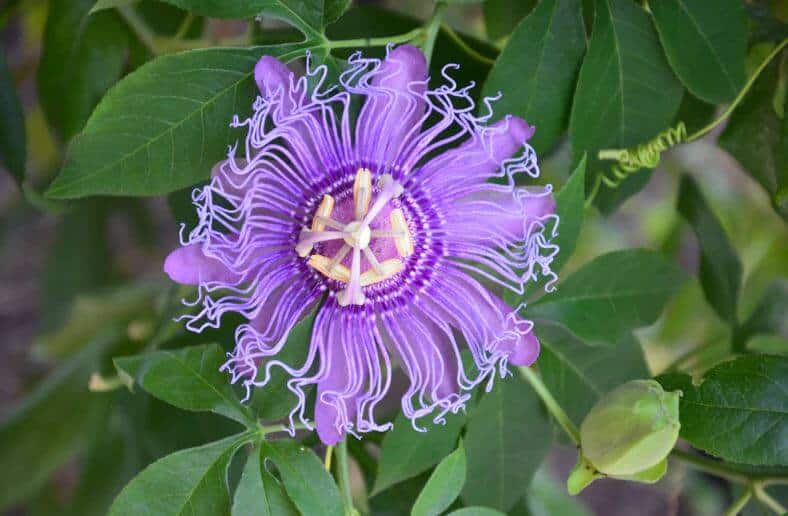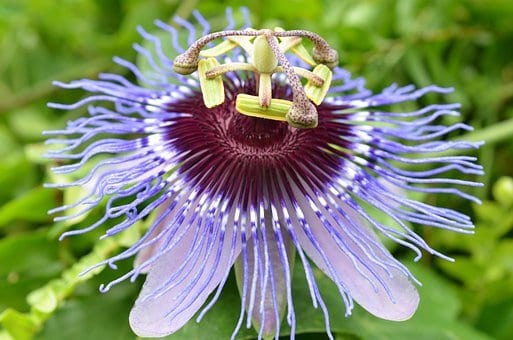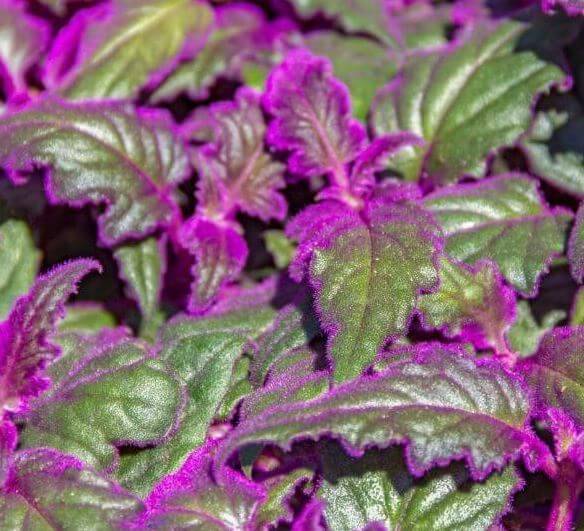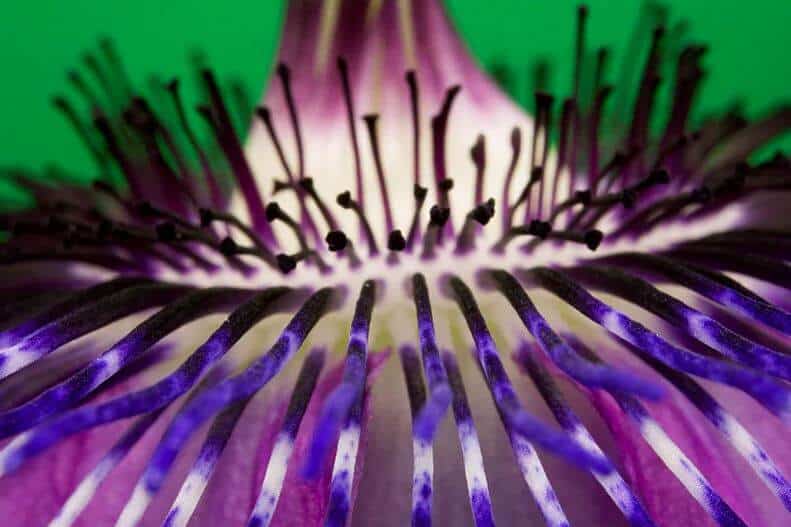Last Updated on January 8, 2023 by a Friendly Gardener
The Purple Passion Plant is botanically known as the Gynura Aurantiaca. This is a popular houseplant because of its striking foliage and lovely flowers. The Purple Passion Plant is a perennial evergreen that belongs to the Asteraceae family. Its native habitat is found in Java and Indonesia. Being a tropical plant it will thrive in outdoor gardens in USDA hardiness zones 10, 11, and 12,
When searching for this plant at your local garden center or nursery, it is often sold under another name such as the Royal Velvet Plant or the Purple Velvet Plant. Other Purple Passion Plant cultivars can be found under the names Purple Passion Vine or Purple Passion Plant. Due to its tropical nature, it is commonly cultivated indoors as a houseplant.
The striking foliage is a dark green covered in purple-hued hair. Leaves feature a velvety texture which explains several of its popular names. Leaves are oval-shaped or elliptical-shaped and jagged leaf edges make them even more exotic in appearance. They can grow to be 8-inches long. It’s an impressive addition to any home garden.
The Purple Passion Plant flowers with bright yellow blooms look like dandelions. The flowers have an unpleasant smell and trimming them will remove the odor.
The Purple Passionis a rapid grower. While young it will grow pointing upward. Mature plants will spread and sprawl, growing as much as two feet long. Consequentially, young plants are a delightful choice on tables or placed in windows and mature plants lend themselves to hanging baskets and high shelves.
Purple Passion Plant Care

Soil
Purple Passion plants can be cultivated in basic but quality potting soil. Containers need to have good drainage.
Light
The Purple Passion plant requires filtered indirect medium light. A sunny north-facing window would be a perfect choice. Locations with stronger sunlight require an observant eye as strong sunlight exposure can scorch the foliage.
Too little light will also be a problem as your plant leave will reach for the sun making it leggy and weakening its overall health. You can place the Purple Passion plant in a window with stronger sunlight as long as it has at least a sheer curtain for protection.
Water
YourPurple Passion prefers an evenly moist soil bed. It will not do well in soggy soil. Like many houseplants, it is ì at risk for root rot caused by overwatering. When the top inch of the soil bed is dry, you can water it.
Humidity

The Purple Passion plant is a tropical plant, so it likes humidity. Consider watering this plant from the bottom by setting the container in a dish of water and permitting it to soak up what it needs. Avoid getting foliage wet, so avoid misting as well.
If your home or office has dry air, and you need to increase humidity, use a space humidifier, or a pebble tray. Fill a tray with tiny rocks and fill it to the stone level with the water. Place your Purple Passion plant on the tray. The plant container should avoid coming into contact with the tray water. You can also try grouping several plants together as transpiration will increase humidity in the immediate area of the plants.
Purple Passion Plants should not be selected for closed terrariums. Closed terrarium humidity is too high and will cause the plant to suffer damage. You can try an open terrarium with the correct size of the plant.
Temperature
When you cultivate a Purple Passion plant indoors, it requires little to no care. It is an ideal houseplant for those with little time and for beginners. It does best in temperatures measuring from 60° to 70° Fahrenheit.
Feeding
You can feed your Purple Passion plant with an all-purpose houseplant food every other week during its growing season. When your plant enters winter dormancy, reduce fertilization to once every two months.
Purple Passion Plant Propagation

You can easily propagate your Purple Passion plant with stem cuttings. Snip a two-to-four-inch section from the mother plant and remove leaves from the bottom half of the cutting. You can cultivate the stem cutting in water, starting mix, or in vermiculite. When using a growing mix, coat the cut end in rooting hormone before you insert it into a growing medium. Once the stem cutting develops roots, transplant it into potting soil.
Pruning
For a bushier appearance, trim back your Purple Passion plant and use any cuttings to propagate. Smaller plants thrive when allowed to be slightly root-bound. This condition also aids in controlling the size.
As your plant matures, it will lose some color as it grows and spreads. Pruning tips will encourage new growth and help to increase its striking color. Should your plant lose all color, propagate a new plant using a stem cutting. Mature plants are lovely when placed in hanging baskets or allowed to climb on trellises.
Repotting

Unfortunately, these plants do not enjoy a long lifespan so repotting will probably not be necessary.
Disease, Pests, and Problems
A Purple Passion plant is susceptible to many common pests that afflict houseplants such as spider mites, aphids, and scale. At the first sign of an infestation, remove any pests with a moistened cloth. You can also choose to apply an organic insecticidal soup or Neem oil.
These plants are not totally immune to disease, but they are very resistant and hardy. Botrytis and Fusarium infections can cause leaves to brown and die. Diseases are more common in Purple Passion plants cultivated outdoors where contamination from the soil, tools, or handling can infect them. Fungicides can help with infected plants. Neem oil also functions as an organic fungicide. If you suspect a fungal infection, remove them from their pot, and wash the plant roots as well as the pot. Dip the cleaned roots in fungicide and replant your plant in fresh potting soil.
Toxicity
The ASPCA – American Society for the Prevention of Cruelty to Animals informs us that the Purple Passion is non-toxic to family cats and dogs.
Flowers and Leaves

This plant is popular for its striking foliage with deep green leaves covered in purple hairs. The leaves have a sheen that has an appearance like velvet. Plant hairs protect leaves from strong light. Foliage should be kept dry and free of water to prevent rot. The underside of foliage is also a striking purple hue.
Bright yellow blooms resemble the common dandelion found on lawns. They emit a notably unpleasant smell. If your indoor Purple Passion plant produces blooms, it is a sign of plant maturity and you can now take stem cuttings for plant propagation.
A Final Consideration

If purple and velvet delight your senses, this is a fantastic houseplant for cultivation. The Purple Passion plant asks little of its owner yet adds a stunning splash of color when placed in any home or office décor.

